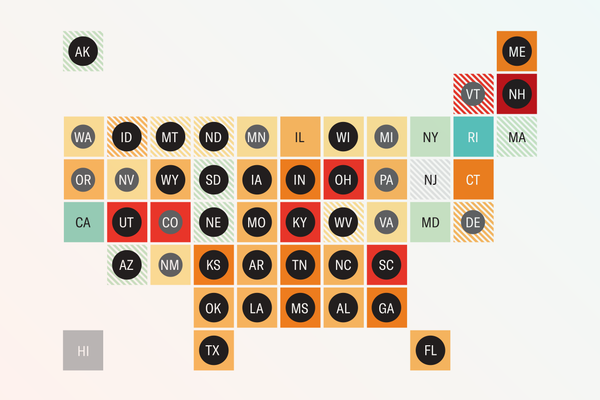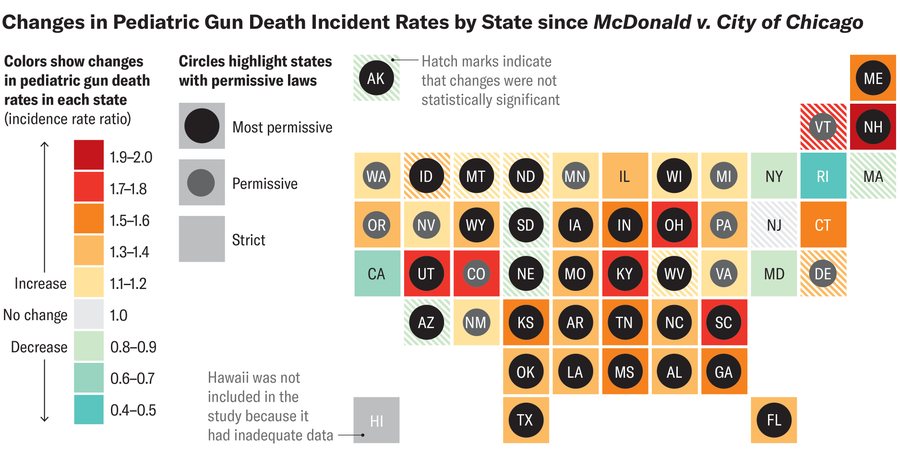
New Map Shows How Gun Deaths of Children Have Increased in States with Loose Firearm Laws
Gun violence is the leading cause of death of children in the U.S.—and states with loose gun control laws bear the heaviest burden, a new study found

Gun violence has been the leading cause of death of children and adolescents in the U.S. since 2020. Now research shows that, since 2010, these rates have increased in states with permissive firearm laws and decreased in states with strict laws.
The new study, published on Monday in JAMA Pediatrics, compared gun deaths in U.S. states before and after the landmark Supreme Court case McDonald v. City of Chicago. The Court’s 2010 decision limited states’ ability to regulate gun access, and many states loosened firearm ownership requirements after the ruling.
The researchers sorted each U.S. state into one of three categories—”strict,” “permissive” and “most permissive”—based on its firearm laws. Relatively strict states had requirements such as safety trainings, background checks and waiting periods. They also tended to ban assault weapons and certain gun-enhancing hardware such as bump stocks (which can make a rifle fire much more rapidly). The more permissive states had limited requirements for gun ownership, as well as laws that allowed the concealed carry of firearms with or without a permit, the use of deadly force as self-defense (such as via “stand your ground” laws), and more.
On supporting science journalism
If you’re enjoying this article, consider supporting our award-winning journalism by subscribing. By purchasing a subscription you are helping to ensure the future of impactful stories about the discoveries and ideas shaping our world today.
The researchers compared each state’s rate of pediatric deaths from firearms between 1999 and 2010 with the rate during the period between 2011 and 2023 using data from the U.S. Centers for Disease Control and Prevention. Of the 49 states with adequate data, firearm death rates increased significantly in 33 states, 31 of which were considered “permissive” or “most permissive.” Rates decreased significantly in four states, all of which were considered “strict.”

The researchers also used the historical data from 1999 to 2010 to predict the number of childhood firearm deaths that would be expected in 2011 to 2023. States with more permissive gun laws were more or less on trend, with a total of 55 fewer childhood gun deaths than expected between 2011 and 2023. But states with permissive gun laws saw a total of 1,424 more childhood deaths from firearms than expected. In the most permissive states, the number was 6,029.
“Nationwide, you’re looking at 23,000 deaths over 13 years instead of 16,000,” says the study’s lead author Jeremy Faust, an emergency room physician at Brigham and Women’s Hospital and an instructor at Harvard Medical School. This burden was spread across urban, suburban and rural communities but affected Black communities the most.
The data cannot prove that the different laws caused this disparity. Deaths that didn’t involve firearms, including homicides and suicides, however, did not show this state-by-state effect.

There are two notable outliers in the data—Illinois and Connecticut. These two states were in the strict category but had significant increases in death rate. For Illinois, “I don’t have a great explanation, but someone should look into that,” Faust says. Yet “if you exclude one day from Connecticut, the Sandy Hook massacre, you don’t have an increase.” The school shooting, which occurred in 2012 and killed 20 children and six adults, led to the stricter gun laws that Connecticut has today.
“We live in a society where we have these rights, but we also live in a society that has 50 different interpretations of how to make that work. And I think that we need to start to study what is working,” Faust says. “A place like New Hampshire may not have the same solution as a place like California. [The solution] is not going to be one-size-fits-all.”
IF YOU NEED HELP
If you or someone you know is struggling or having thoughts of suicide, help is available. Call or text the 988 Suicide & Crisis Lifeline at 988 or use the online Lifeline Chat.
Source link






